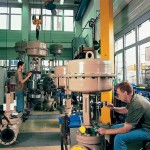The Samson product portfolio ranges from rugged, self-operated regulators to highly specialised process valves. The company produces valves in all sizes and materials, which can be combined with various actuators. In addition, the associated companies of the Samson Group also address the needs of niche markets, allowing Samson to act as a main valve vendor and provide solutions for all control applications.
The advantages of medium-sized German companies become apparent in the midst of the the economic crisis. Many family-owned companies in Germany are not financially reliant on banks and finance investments from their own means. Some managers might call this approach outdated, whilst others see in it a competitive edge, as is the case at Samson AG. Samson’s sustained success proves the managers right. The family-owned business achieved an 11.9 % increase in sales in the 2007/2008 fiscal year. And despite the financial crisis, Samson expects the good results to continue in 2008/2009. The firm has invested in a modern logistics centre at its headquarters in Frankfurt as well as a new office building to accommodate sales staff and training facilities. In addition, far-sighted planning of the Frankfurt site meant that sufficient space remains available for expansion.
Companies serving the process industry have to react particularly quickly to market developments and set up production facilities throughout the world within a short time. When doing so, they prefer to work with as few suppliers as possible to minimise technical problems brought about by the interaction of various plant components. Questions of responsibility in the event of failure and warranty issues are thus avoided. This is why all-in-one solutions and fast customer support on a worldwide basis are called for. Only those companies that can meet these requirements are considered suitable suppliers for large-scale engineering projects. For this reason, Samson has systematically extended its product range over the years. In Air Torque, Leusch, Pfeiffer, Samsomatic, Starline, Vetec and Welland & Tuxhorn, the Samson Group has its own competence centres for all relevant sectors of control engineering, far beyond its own core area of expertise in the field of globe valves. Thanks to digital positioners, Samson also masters the integration of control valves into all common process control systems. The company regards itself as a main valve vendor that supplies cost-effective control devices for all control applications from one source.
Extensive in-house production
Globalised business has led to the advance of just-in-time manufacturing and delivery. A different set of rules applies to highly complex technologies involving individual customer specifications or products that must operate reliably over a long service life even, under the severest operating conditions. As the outcome of all this, the widest possible range of in-house manufacturing capabilities is indispensable to be able to respond quickly to the most diverse customer requirements, while keeping the quality standard high. This is the reason why practically all essential parts are manufactured at Samson’s own facilities, including some components that, to the untrained eye, would be hardly registered as such. To begin with, there are the bodies used for control valves and self-operated regulators, for which a variety of materials are available. The valve body blanks are normally machine-cut in a few work steps on ultra-modern, high-tech CNC machining centres. The machines are responsible, for example, for machining the flange contours, milling the flange faces and drilling the necessary bolting patterns. Workpieces from the smallest valve body to heavy blanks weighing a few tons for 20 inch types only need to be loaded into the workholder a few times. The newest CNC machining centre at Samson has led to a dramatic reduction in processing times, as transportation and standing times no longer exist.
In view of the wide diversity of materials that need to be joined together, there is a real art to welding. For instance, valve stems are commonly made of steel alloys containing chromium, nickel and molybdenum. Yet, in isolated cases, customer specifications require the valve plug attached to the end of the plug stem to be made of Monel. First of all, this entails verifying numerous details, such as ensuring that the materials are heated up to the correct temperature and cooled off at the right rate or that the proper weld filler metal is chosen. Additional requirements to be taken into consideration include drawing up welding procedure specifications and strict adherence to specifications recorded in detail in the product documentation.
Creating surface finishes that do not react even in corrosive atmospheres is one of Samson’s core competences. The Frankfurt production facilities include electroplating plants, allowing a whole series of surface treatments to be performed in-house. Steels are zinc-plated and chromated in the rack installation, whereas copper alloys undergo nickel-plating to obtain an attractive finish. A basket system is used to handle parts that require more complex passivation treatment. A phosphate coating, for example, is applied to iron parts to promote the formation of a passive film that protects them against corrosion. Die-cast aluminium parts are chromated to inhibit the detrimental effect of blistering in corrosive atmospheres. The pickling process removes any ferrite residue left over from the machining process on stainless steel parts. Workpieces to be used with high-purity water or gases undergo the same treatment. In the paint shop, the typical light-beige powder paint is applied to valves and devices, except when customer specifications call for a special coat in a different colour or with a different texture.
Diaphragm production
Samson’s in-house diaphragm production started in the 1970s to permit a prompt response to calls for pneumatic actuators, even in times of increased demand. What at first glance looks like a simple rubber part turns out, on closer inspection, to be a key component that has to cope with extreme stress over the long service life of the control valve. The best sealing performance and an exact restoring ability over several hundred thousand cycles at extremely high or low temperatures depend on the correct selection of the reinforcement fabric, elastomer materials and vulcanisation techniques. The proportion of control valves with integrated electronic components that perform key duties like control, valve diagnostics and communication is steadily increasing. For instance, the latest series of positioners from Samson come with an on-board microprocessor, which is tuned to the instrument and customer requirements.
This focus on providing custom solutions rather than mass-produced goods even means that Samson itself mounts electronic components on its own printed circuit boards.
Six million parts in stock
A well organised process is set off as soon as an order arrives from the sales department and all technical specification matters have been clarified. A typical order could involve, say, 50 control valves for a chemical company, required in various materials and nominal sizes and with different pressure ratings, some of them also equipped with numerous valve accessories, such as positioners or solenoid valves. The parts needed for the order are compiled by the warehouse management software system and printed out on an order sheet.
The logistics centre contains over 20,000 different products and a total of six million individual parts are kept in stock. Most of these parts are housed in the high-bay warehouse inaugurated in 2002, consisting of ten rows of shelves with 29 racks and providing more than 13,500 spaces in total for storing pallets and wire mesh boxes. Five computer-controlled stacker cranes grant quick access to all pallets and boxes, placing them on the automated conveyor system and forwarding them to the pick/pack area. At the pick/pack workplace, the responsible employee from the logistics team removes the necessary parts and places them on pallets. 160 pallets per hour can be moved within the warehouse.
Quality assured
Pilot lots and components for critical processes undergo a 100 % inspection. To be able to fully rule out cracks in pressure-bearing parts, a magnetic particle inspection or a dye penetration test is performed. Microscopic surface faults are made visible in this way. After their final assembly, all positioners and pressure-bearing devices are subjected to a final test in several stages to check their dimensions, functions and any installed software. The data contained in the test certificate allows each item to be traced back to its origin. Samson’s quality consciousness is simultaneously expressed in the extensive diagnostic functions of its modern positioners. During automatic initialisation as well as normal operation, data is recorded and possible sources of faults detected. The standard diagnostic data mainly focuses on the positioner itself. Advanced diagnostics also include status messages concerning the state of the valve, actuator and air supply, which can be generated after the valve position, setpoint and drive signal have been analysed. The positioner requires raw data for this purpose. During operation, the positioner monitors the relevant signals and the built-in microprocessor analyses them. The standard diagnostics supply key information, such as zero shifts and changes in control accuracy, for predictive maintenance over Hart, Profibus or Foundation Fieldbus protocols. An alarm is generated if the valve travel exceeds the specified maximum limit. The positioner keeps track of the number of initialisations, zero calibrations, changed configurations and operating hours since the first and last initialisation. Its self-monitoring functions allow it to detect and issue error alarms, differentiating between errors that can be corrected automatically and those that require a reset. An in-depth error analysis is provided by the Expert+ valve diagnostics. This on-board firmware includes a data logger and plots histograms for the valve position, system deviations and changes from the end position. By comparing the recorded data with the reference data saved during initialisation, Expert+ is able to recognise faults and trends.
Series 3730 and 3731 positioners with firmware Version 1.5 or higher include the basic diagnostics as well as the advanced Expert+ diagnostics as standard. A partial stroke test can also be performed to check the functioning of on/off valves while they are in service. Upgraded with additional sensors, Expert+ can indicate seat leakage and the occurrence of cavitation.
Samson AG info@samson.de www.samson.de


cpp: On 1 October, you took over Prof. Heinfried Hoffmann’s position as member of the executive board responsible for research and development. Do we have to expect great changes at Samson?
Kiesbauer: Under Prof. Hoffmann’s leadership in the field of R&D, Samson experienced the transformation from electromechanical valves to smart valves as part of the fusion of mechanical, electronic and software components at the end of the 1980s. The modular approach typically used to construct Samson valves was and still is important for valves covering a wide variety of applications, such as cryogenic valves for the booming LNG sector or control valves for the pharmaceutical industry. Samson always carried out groundwork for this, partly in house and partly together with universities. I was involved in a lot of development projects. We want to continue this successful course and push ahead with new developments as we have done so far.
cpp: Where do you see areas for improvement?
Kiesbauer: In these days the focus for the actual valve construction lies on detail development, we still have a long way to go where the development of digital technology is concerned, despite many technical innovations in the past few years. Today, plant users rely on optimized process operations, which is why they place higher demands on the field devices concerning functionality and maintenance to reduce life cycle costs. They only recently started to use digital technology properly for these purposes. This will, of course, lead to new ideas and mean further developments in the fields of diagnostics and valve accessories. Wireless solutions will also open up new possibilities. Automated on/off valves add additional impetus to new digital valve accessories, which are especially tailored to these valves. The main function of control valves, i.e. positioning the valve properly, is becoming more and more challeng-ing, while valves get larger and larger. This calls for valves that are easy to adjust and maintain. Reliability and safety also demand more knowledge about critical states, such as cavitation, flashing, process media containing solids etc., which means further research needs to be done.
cpp: In the past few years, Samson has established itself as a main valve vendor. What advantages does this bring?
Kiesbauer: By extending our own modular globe valve ranges and the strategic alliances with our associated companies, especially in the rotary valve sector, we have considerably extended our product portfolio to offer the entire valve range from ½ inch micro-flow valves to 60 inch triple eccentric butterfly valves. Nevertheless, a main valve vendor must also be able to supply more than just the different types of valves. The common link between all these valves at Samson are the smart valve accessories, such as digital positioners. What is more, these positioners must also be integrated correctly into a wide variety of process control systems using EDDL or FDT/DTM.
cpp: Achema, the most important trade fair for the process industry, is coming up soon. What impetus do you expect from Achema and which products will we see there?
Kiesbauer: From the valve manufacturer’s viewpoint, wireless technology will, of course, be a key topic. Additionally, new functions and possibilities will be provided by valve accessories. We will be presenting new smart valve accessories, also with wireless technology. Further developments in valve technology will be on display as well.
Share:










